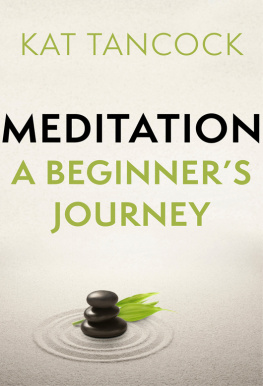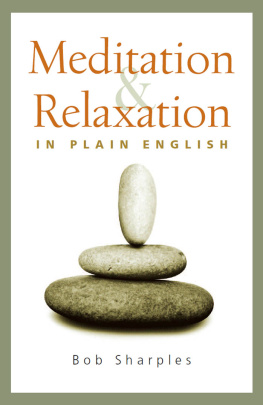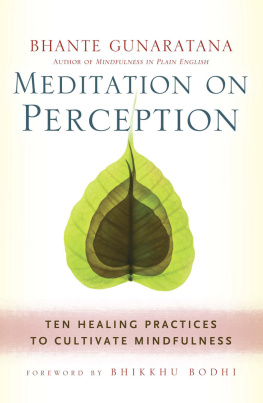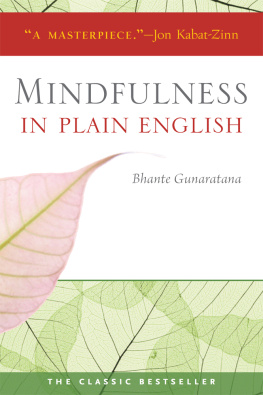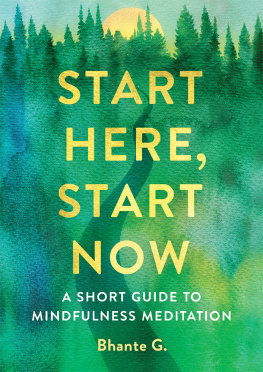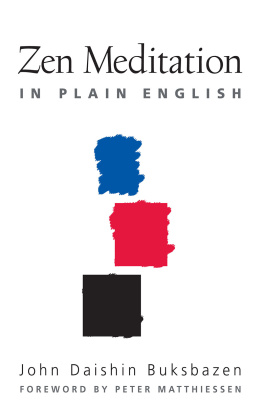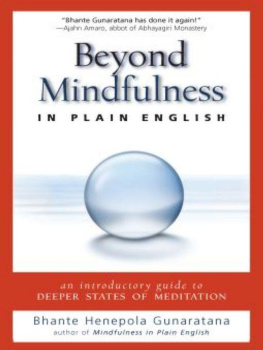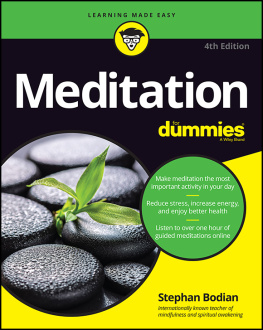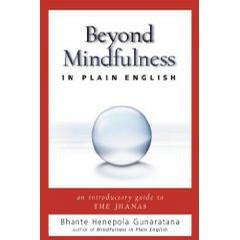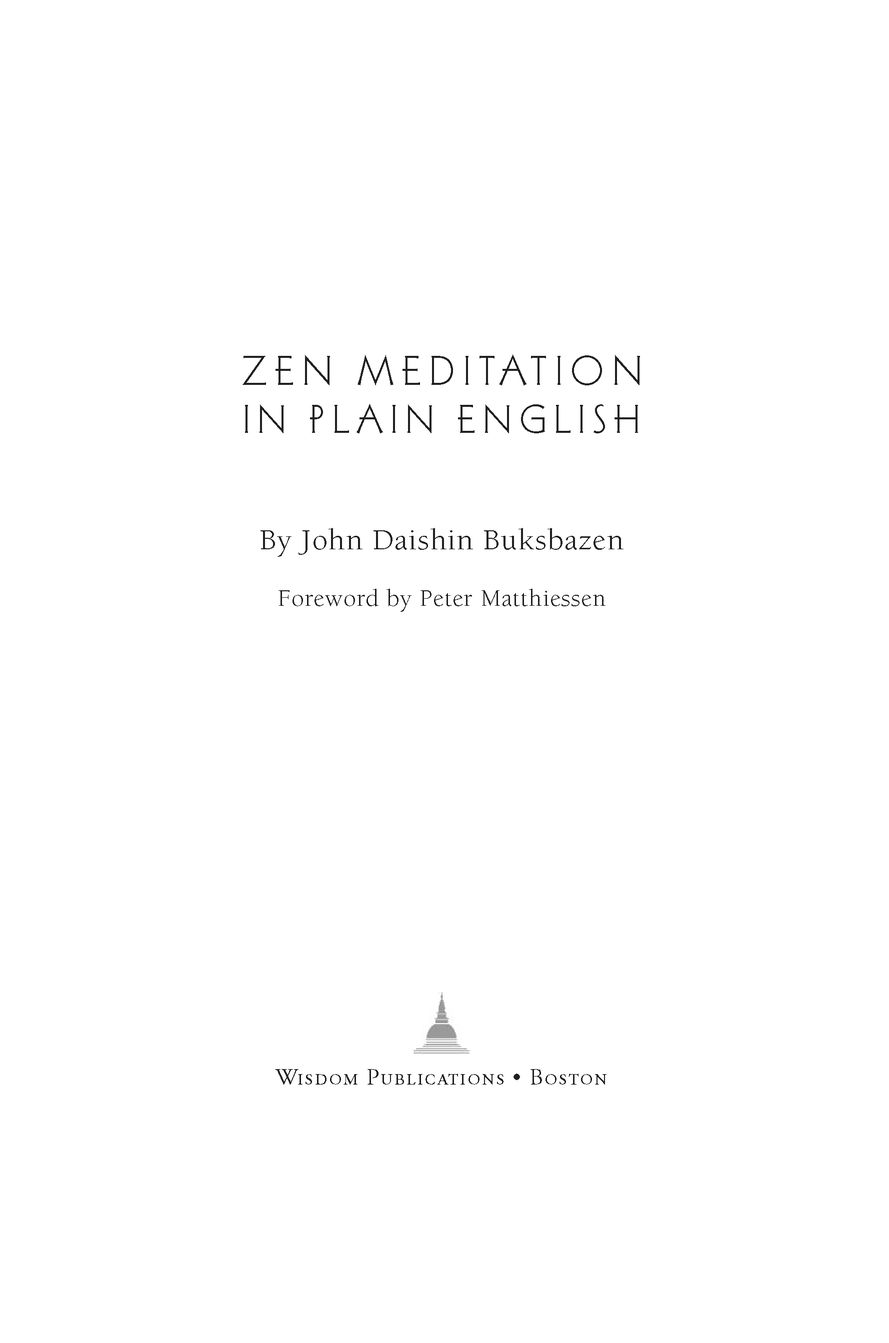Table of Contents
PRAISE FORZEN MEDITATION IN PLAIN ENGLISH
Here is a lucid guide to the first step of any serious spiritual journey. All of the usual fat that accompanies works of this type has been trimmed away, leaving the bones and marrowthe essentials that any newcomer needs to know to enter the way.
John Daido Loori Roshi
Abbot of Zen Mountain Monastery
Authentic Zen meditation is easy if you are given clear, step-by-step instructions. This wonderful book gives just such instructions and teaches you how to calm your body, breath, and mind. Follow these steps, and right here, now, you will be on the path of the ancient Zen masters.
Sensei Wendy Egyoku Nakao
Abbot of Zen Center of Los Angeles
John Buksbazens book is an authentic presentation of a universal and timeless teaching, particularly valuable because of the practical clarity and warmth of its style.
Dennis Genpo Merzel Roshi
Abbot of Kanzeon Zen Center
Clear, simple, and well-grounded in years of experience, Daishins book is a real gift to anyone interested in Zen practice.
Bernie Glassman Roshi,
Founder of the Zen Peacemaker Order
To my teachers,
Taizan Maezumi Roshi,
Roshi Bernie Glassman,
Sensei Wendy Egyoku Nakao;
to my wife
Concetta F. Alfano;
and to my dear friend
Rick Fields,
this book is gratefully dedicated.
You showed me the Way.
ACKNOWLEDGMENTS
SPECIAL THANKS to my editor at Wisdom Publications, Josh Bartok, without whose patient and writer-friendly guidance this book would not have ripened as it did.
Great appreciation also to my Dharma teacher and Abbot of Buddha Essence Temple, the Zen Center of Los Angeles, Sensei Wendy Egyoku Nakao, for her encouragement and support throughout this project and in my life. And to my wife, Concetta, for who she is.
I am also most grateful to the sangha of ZCLA, and especially to my fellow Zen practice instructors, for their help in putting together the Frequently Asked Questions section of this book.
FOREWORD
Peter Matthiessen
THIS GENTLE BOOK, reflecting the wise teachings of Taizan Maezumi Roshi, is a wonderful introduction to Zen Buddhism, and also an invitation to new life. To practice Zen means to realize ones existence in the beauty and clarity of this present moment, rather than letting life unravel in useless daydreaming of the past and future. To rest in the present is a state of magical simplicity, although attainment of this state is not as simple as it sounds: most of us need dedicated training under the guidance of a roshi (a Zen master) in order to let the debris of existence fall away. From the very beginning, the sitting meditation called zazen will bring about a strong sense of well-being, as body and mind return to natural harmony with all creation; later there comes true insight into the nature of existence, which is no different from ones own true nature, or the nature of the Buddhawhose name means The-One-Who-Knows.
Zen has been called the religion before religion, which is to say that anyone can practice, even those committed to another faith. And the phrase evokes that natural religion of our early childhood, when heaven and a splendorous earth were one. For the new child in the light of spring, there is no self to forget; the eye with which he sees God, in Meister Eckharts phrase, is the eye with which God sees him. But that clear eye is soon clouded over by ideas and opinions, preconceptions and abstractions, and simple being becomes encrusted with the armor of ego. Not until years later does an instinct come that a vital sense of mystery has been withdrawn. The sun glints through the pines, and the heart is pierced in a moment of beauty and strange pain, like a memory of paradise.
After that day, there is no beauty without pain, and at the bottom of each breath, there is a hollow place that is filled with longing. That day we become seekers without knowing that we seek, and at first, we long for something greater than ourselves, something far away. It is not a return to childhood, for childhood is not a truly enlightened state; yet to seek ones own true nature is, as one Zen master has said, a way to lead you to your long-lost home.
Most of us cast about for years until something in our reading, some stray word, points to the vague outlines of a path. Perhaps this book is the beginning of your homeward way; if so, count yourself lucky, for it offers no tangled analyses, no solutions, only the way to forgetting the self, the way to zazen, to just sitting. Through zazen, ideas dissolve, the mind becomes transparent, and in the great stillness of samadhi (Melville called it, that profound silence, that only voice of God), there comes an intuitive understanding that what we seek lies nowhere else but in this present moment, right here now where we have always been, in the common miracle of our own divinity. To travel this path, one need not be a Zen Buddhistcall yourself a zazen Buddhist if you like! Zen Buddhist is only another idea to be discarded, like enlightenment, or Buddha, or God.
INTRODUCTION
ZEN BUDDHISM, according to various authorities, is a religion, or a philosophy, or a way of life, or a mental and physical discipline. Some say it is all of the above; others say it is none.
Fundamentally, Zen is a way of seeing clearly who we are and what our life is, and a way of living based on that clear vision.
Many people wonder what Zen is all about, and how it works. They find much of the literature about Zen confusing and are unclear about how it applies to daily living.
This book is in large measure directed to those people. Its aim is to give enough information to get them started in Zen practice, especially in the form of seated meditation called zazen or just sitting. The assumption is that this practice will do more for the inquiring individual than reading any number of books or articles. Once actual practice has begun, then books (carefully chosen for their relevance and reliability) can enrich and broaden ones understanding. But if there is not a sound foundation of experience, then the books will remain undigested in the domain of intellect, and not be of much use.
After all, cookbooks are fun to read, but they arent very nutritious. They are most helpful to somebody who is actually involved in cooking.
So once youve read this book, the next step is to start practice. If your community has a Zen teacher, so much the better. If not, then you are on your own until you find one, and encouraging you to do that is another of the aims of this book. It is intended to give you enough information to get you started and keep you going until you can find and begin practice with a qualified teacher, either of Zen or of one of the related practices, such as Insight Meditation or Tibetan Buddhism.
Keep this in mind, though: sooner or later, you really must study with a teacher, for the practice is long and not easy, and there are many opportunities to become discouraged or confused along the way.
Also, as you progress you will have experiences youll want to discuss and questions that should be reliably answered. This process should be addressed on a personal basis by a qualified teacher who knows you and can deal with you directly. But this book can keep you going until you and your teacher meet.


